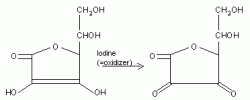- Joined
- Jan 7, 2003
- Messages
- 2,373
Today I had a local pharmacy make my up 100 capsules containing 50 mg of ascorbic acid (Vitamin C). I plan to try to use them to neutralize the iodine I put in the water to sterilize it.
I recently took five guys out on their first survival camping trip and quickly realized that I was going to run through my meager supply of Potable Aqua Plus in one long weekend trying to keep six people hydrated. The PA Plus tablets are merely 45 mg of ascorbic acid according to the lable.
I taught them how to use Iodine solution, 5 drops per canteen for water purification. This is fine for drinking but becomes a problem when you try to cook anything containing starch. Oatmeal turns bright blue; rice water starts getting darker and darker. The water post-treated with ascorbic acid doesnt do this.
Im going to try this experiment later today once the capsules get here. One hundred capsules of pure ascorbic acid cost me $3.50. A 50 ml bottle of Iodine drops costs about $.75.
I may have to play around with the dosage but Ill keep you posted. Has anyone ever tried this before? Mac
I recently took five guys out on their first survival camping trip and quickly realized that I was going to run through my meager supply of Potable Aqua Plus in one long weekend trying to keep six people hydrated. The PA Plus tablets are merely 45 mg of ascorbic acid according to the lable.
I taught them how to use Iodine solution, 5 drops per canteen for water purification. This is fine for drinking but becomes a problem when you try to cook anything containing starch. Oatmeal turns bright blue; rice water starts getting darker and darker. The water post-treated with ascorbic acid doesnt do this.
Im going to try this experiment later today once the capsules get here. One hundred capsules of pure ascorbic acid cost me $3.50. A 50 ml bottle of Iodine drops costs about $.75.
I may have to play around with the dosage but Ill keep you posted. Has anyone ever tried this before? Mac

